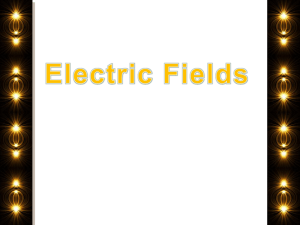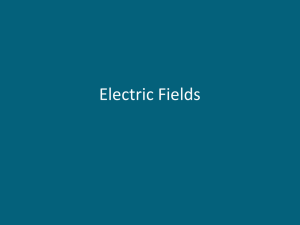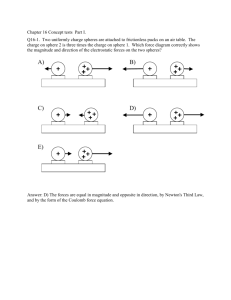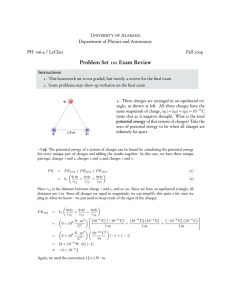Problem Set 10: Exam Review U A Department of Physics and Astronomy
advertisement
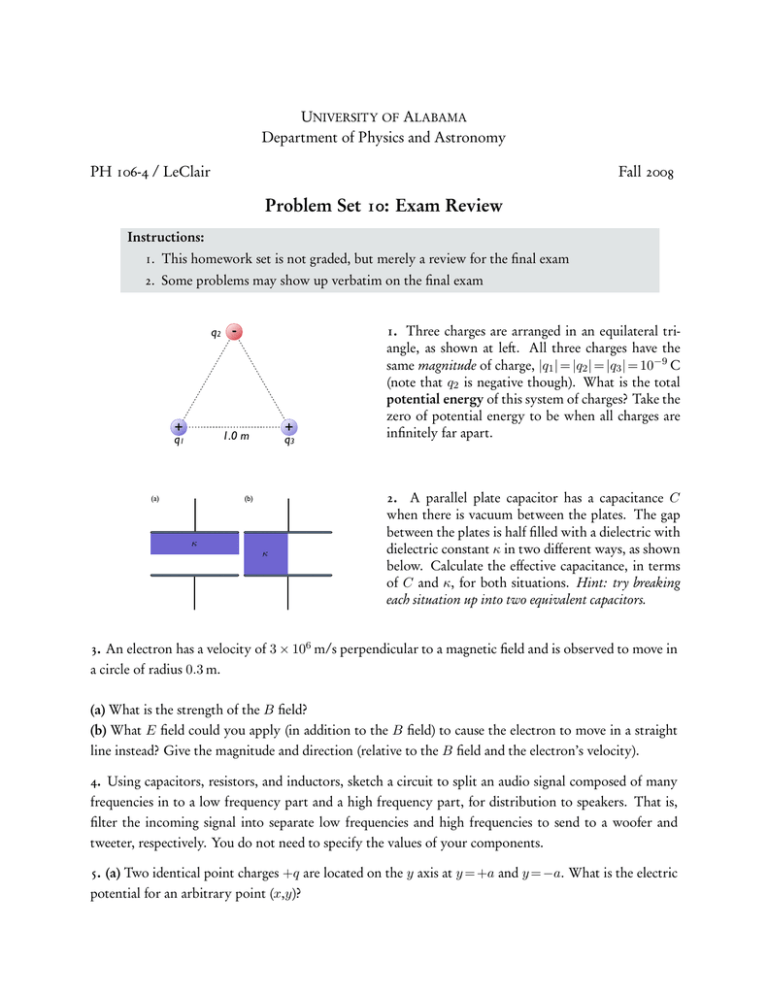
UNIVERSITY OF ALABAMA Department of Physics and Astronomy PH 106-4 / LeClair Fall 2008 Problem Set 10: Exam Review Instructions: 1. This homework set is not graded, but merely a review for the final exam 2. Some problems may show up verbatim on the final exam q2 + - + 1.0 m q1 (a) q3 (b) κ κ 1. Three charges are arranged in an equilateral triangle, as shown at left. All three charges have the same magnitude of charge, |q1 | = |q2 | = |q3 | = 10−9 C (note that q2 is negative though). What is the total potential energy of this system of charges? Take the zero of potential energy to be when all charges are infinitely far apart. 2. A parallel plate capacitor has a capacitance C when there is vacuum between the plates. The gap between the plates is half filled with a dielectric with dielectric constant κ in two different ways, as shown below. Calculate the effective capacitance, in terms of C and κ, for both situations. Hint: try breaking each situation up into two equivalent capacitors. 3. An electron has a velocity of 3 × 106 m/s perpendicular to a magnetic field and is observed to move in a circle of radius 0.3 m. (a) What is the strength of the B field? (b) What E field could you apply (in addition to the B field) to cause the electron to move in a straight line instead? Give the magnitude and direction (relative to the B field and the electron’s velocity). 4. Using capacitors, resistors, and inductors, sketch a circuit to split an audio signal composed of many frequencies in to a low frequency part and a high frequency part, for distribution to speakers. That is, filter the incoming signal into separate low frequencies and high frequencies to send to a woofer and tweeter, respectively. You do not need to specify the values of your components. 5. (a) Two identical point charges +q are located on the y axis at y = +a and y = −a. What is the electric potential for an arbitrary point (x,y)? 6. Using an electromagnetic flowmeter (see figure), a heart surgeon monitors the flow rate of blood through an artery. Electrodes A and B make contact with the outer surface of the blood vessel, which has inside diameter 3.2 mm. Permanent magnets outside the blood vessel create a magnetic field perpendicular to the blood flow direction. For a ~ = 0.037 T, a potential magnetic field strength of |B| difference of ∆V = 160 µV appears between the electrodes. (a) Calculate the speed of the blood. (b) Does the sign of the potential difference depend on whether the mobile ions in the blood are predominantly positively or negatively charged? artery + A S electrodes V N - B blood flow 7. A circular ring of charge of radius a has a total positive charge Q distributed uniformly around it. The ring is in the x = 0 plane with its center at the origin. What is the electric field (both magnitude and direction) along the x axis at an arbitrary point x = b due to the ring of charge? Hint: Consider the total charge Q to be made up of many pairs of identical charges placed on opposite points on the ring. y +Q - 2Q +Q x (-d,0) (d,0) 8. The charge distribution shown is referred to as a linear quadrupole. (a) What is the electric potential at a point on the x axis, where x > d? (b) What is the electric field for an arbitrary point (x,y)? 9. A group of students on spring break manages to reach a deserted island in their wrecked sailboat. They splash ashore with fuel, a European gasoline-powered 240 V generator, a box of North American 100 W, 120 V lightbulbs, a 500 W 120 V hot pot, lamp sockets, and some insulated wire. While waiting to be rescued they decide to use the generator to operate some bulbs. (a) Draw a diagram of a circuit they can use, containing the minimum number of lightbulbs with 120 V across each bulb, and no higher output. (b) One student catches a fish and wants to cook it in the hot pot. Draw a diagram of a circuit containing the hot pot and the minimum number of lightbulbs with 120 V across each device, and not more. Find the current in the generator and its power output. 10. A single atomic layer of singly-charged ions (charge +e) can be arranged on a neutral insulating surface in one of two ways: either as a square or a triangular lattice. For four ions in the former configuration, and three in the latter, calculate the potential energy per unit charge. Which lattice is more stable? a a +e +e 11. Three capacitors of 2, 4, and 6 µF, respectively, are connected in series, and a potential difference of 200 V is established across the whole combination by connecting the free terminals to the battery. (a) Calculate the charge on each capacitor. (b) Find the potential difference across each capacitor. 12. Three equal positive charges, each of magnitude Q, are held fixed at the corners of a square of side a. (a) Find the magnitude and direction of the electric field at the fourth corner. (b) Find the potential at the fourth corner. (c) How much work would be done in moving a fourth charge q to the fourth corner. Hint: What is the change in the energy of the system? 13. You are given a voltage source, several very precise resistors, and two very accurate voltmeters. The voltmeter has an internal resistance of 100 MΩ. Design a circuit to determine accurately the resistance of an unknown specimen, and estimate an upper limit on the specimen’s resistance which will maintain 5% accuracy. 14. The walls of a prison cell are perpendicular to the four cardinal compass directions. On the first day of spring, light from the rising Sun enters a rectangular window in the eastern wall. The light traverses 2.57 m horizontally to shine perpendicularly on the wall opposite the window. A prisoner observes the patch of light moving across this western wall and for the first time forms his own understanding of the rotation of the Earth. (a) With what speed does the illuminated rectangle move? (b) The prisoner holds a small square mirror flat against the wall at one corner of the rectangle of light. The mirror reflects light back to a spot on the eastern wall close beside the window. How fast does the smaller square of light move across that wall? 15. Object O1 is 14.8 cm to the left of a converging lens with a 9.0 cm focal length. A second lens is positioned 10.0 cm to the right of the first lens and is observed to form a final image at the position of the original object, O1 . (a) What is the focal length of the second lens? (b) What is the overall magnification of this system? (c) What is the nature (i.e., real or virtual, upright or inverted) of the final image? 16. A dedicated sports car enthusiast polishes the inside and outside surfaces of a hubcap that is a section of a sphere. When he looks into one side of the hubcap, he sees an image of his face 28.0 cm in back of the hubcap. He then turns the hubcap over, keeping it the same distance from his face. He now sees an image of his face 10.8 cm in back of it. (a) How far is his face from the hubcap? (b) What is the radius of curvature of the hubcap? 17. A scuba diver is underwater; from there, the sun appears to be at 30◦ from the vertical. At what actual angle is the sun located (with respect to directly overhead)? The index of refraction of water may be taken as nwater = 1.33, while that of the air may be taken as nair = 1.00.




